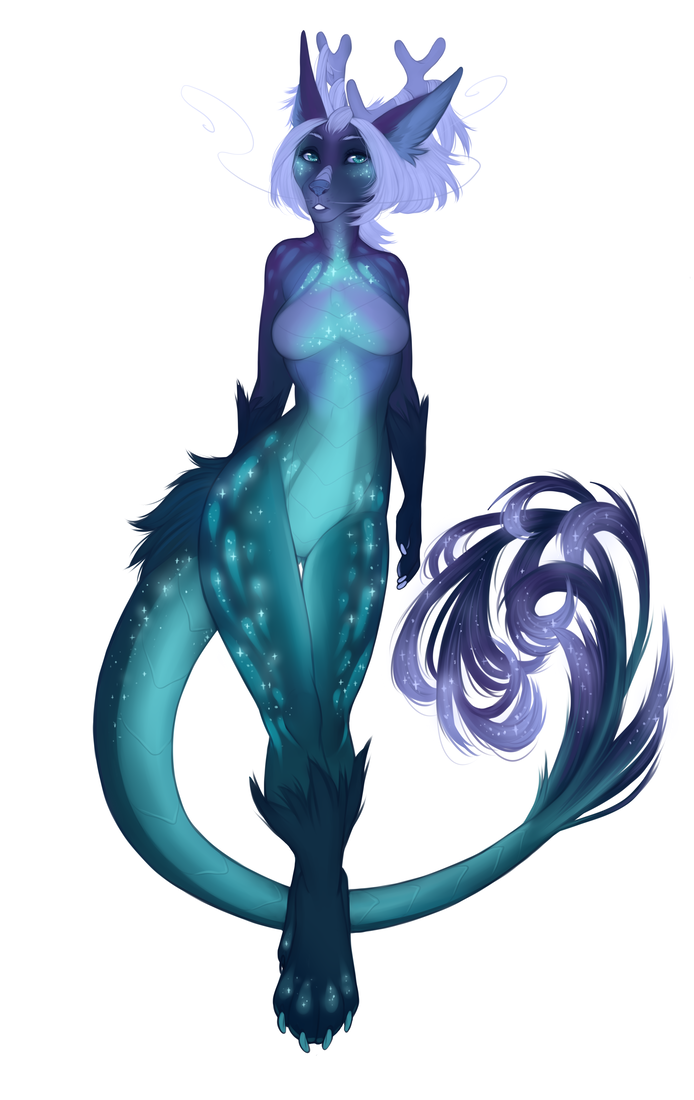Species
Shiji-Long
|
In the vast and diverse realm of Shengdao, the Shiji-Long, often referred to as the common variant, are the embodiment of adaptability. They are the most prevalent sentient beings in this land, and their characteristics vary widely, mirroring the rich mosaic of ecosystems that encompass the continent, but follow certain design aspects. Shiji-Long have both anthropomorphic and feral forms and can freely switch between them, with their feral form enabling them to fly. These dragons exhibit an astonishing array of colors. Whether it's the deep greens of lush forests, earthy browns found in arid deserts, or fiery reds that evoke the essence of volcanic regions, their colours create a stunning visual diversity. Some Shiji-Long boast short, weather-resistant coats, providing protection from the elements. Others, in a display of elegance, possess long, flowing hair and majestic manes that ripple gracefully in the wind, adding a touch of regality to their appearance. While most have long, serpentine tails that enhance their balance and agility, a charming subset of Shiji-Long possesses small, fluffy tails, endearing features that set them apart and accentuate their unique personalities. Ears among the Shiji-Long are diverse, ranging from sharp, pointed ears reminiscent of predatory animals to more rounded, gentle ear shapes akin to herbivores. These ear variations can reflect their ecological niches but do not have to. Horns adorn the tops of their heads, adding to their majestic appearance. These horns come in various shapes and sizes, further enhancing the diversity of their physical characteristics. Some dragons possess long, spiraling horns that convey a sense of age and wisdom, while others bear shorter, more robust horns that hint at their strength and agility. Very rarely Shiji-Long do not possess horns. One of the features of the Shiji-Long is the diversity in their pupils, which resemble those of various animals. Most have vertically slitted pupils, akin to predators. |
 |
What sets the Shiji-Long apart from the other species of Shengdao is their unique life cycle. They live for approximately 200 years, and when their time comes, they undergo a remarkable transformation. They are reborn in an egg, beginning a new cycle of life. This process repeats itself until they either succumb to injury or illness, leaving behind a legacy of wisdom and experiences that continue to shape their communities for generations.
The Shiji-Long are inherently social beings, forming close-knit clans, families and communities around the guidance of their Elders. These clans, often organized by specific regions or shared interests, function as extended families where members support one another through thick and thin, celebrating successes and providing a safety net in times of need. While each clan may have its unique traditions and customs, an overarching sense of unity and kinship unites the entire Shiji-Long population. There still are lone wolves, roaming the land and living by themselves; Shiji-Long who do not need a family or clan to thrive.
Elders play a pivotal role in Shiji-Long society, commanding profound respect. These Elders are powerful dragons, the ancestors of the Shiji-Long. Their wisdom and experiences serve as a guiding beacon for younger generations, helping them navigate decision-making, conflict resolution, and the preservation of cultural traditions. Elders frequently hold leadership positions within clans and communities, their decisions shaping the direction and values of their groups. Their leadership is marked by a deep respect for tradition, tempered by a willingness to adapt to changing circumstances.
Shiji-Long communities often create specific jobs and roles, contributing to the overall well-being of the city, especially Tianshu, the capital. Some clans specialize in agriculture, meticulously tending to the land and cultivating crops to sustain their communities. Others excel in craftsmanship, creating intricate works of art and practical tools that enrich their lives. These specializations not only ensure their people's survival but also showcase the diverse talents within their society.
Cooperation among different clans is common, particularly during times of scarcity or when faced with environmental challenges. This spirit of collaboration underscores their commitment to collective well-being.
